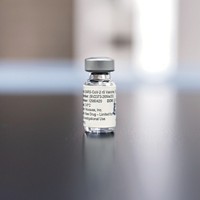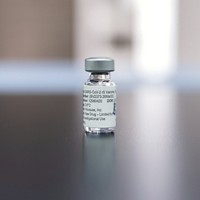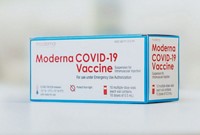Advertisement
Grab your lab coat. Let's get started
Welcome!
Welcome!
Create an account below to get 6 C&EN articles per month, receive newsletters and more - all free.
It seems this is your first time logging in online. Please enter the following information to continue.
As an ACS member you automatically get access to this site. All we need is few more details to create your reading experience.
Not you? Sign in with a different account.
Not you? Sign in with a different account.
ERROR 1
ERROR 1
ERROR 2
ERROR 2
ERROR 2
ERROR 2
ERROR 2
Password and Confirm password must match.
If you have an ACS member number, please enter it here so we can link this account to your membership. (optional)
ERROR 2
ACS values your privacy. By submitting your information, you are gaining access to C&EN and subscribing to our weekly newsletter. We use the information you provide to make your reading experience better, and we will never sell your data to third party members.
Vaccines
Moderna provides cursory glance at first COVID-19 vaccine data
The firm says its experimental mRNA vaccine is safe and induced promising levels of antibodies in a small Phase I clinical trial
by Ryan Cross
May 21, 2020
| A version of this story appeared in
Volume 98, Issue 20
UPDATE
A version of this story was posted on May 18, 2020. It was updated throughout on May 21, 2020 with additional comment.

Preliminary data from a small study of an experimental COVID-19 vaccine developed by Moderna suggest that the vaccine is safe and can spur the immune system to produce antibodies that neutralize SARS-CoV-2, the coronavirus that causes the disease. It’s the first time that results from any COVID-19 vaccine study in humans have been announced.
The news, disclosed May 18, quickly swept the globe and was widely credited as a catalyst for a rise in the stock market. Moderna’s stock soared more than 20%, putting the company’s value at nearly $30 billion—versus about $6.5 billion at the start of the year. The biotech firm said it would raise $1.25 billion in a public stock offering and put the money toward manufacturing its COVID-19 vaccines.
But scientists hoping to parse the news themselves are out of luck. “I was disappointed that they didn’t disclose any data. It is hard to interpret their results without the numbers,” says Laura Walker, director of antibody sciences at the biotech firm Adimab.
Support nonprofit science journalism
C&EN has made this story and all of its coverage of the coronavirus epidemic freely available during the outbreak to keep the public informed. To support us:
Donate Join Subscribe
Moderna announced the news in a press release and a briefing. The firm said the US National Institutes of Health, which conducted the 45-person clinical trial, would publish detailed results before a Phase III trial of the vaccine begins in July.
“The problem with this science by press release is that you don’t see the data. You are asked to trust the company,” says Paul Offit, a pediatrician and director of the Vaccine Education Center at Children’s Hospital of Philadelphia. “What is irresponsible here is that it offers you a shred of hope,” he says, but the small study doesn’t prove that the vaccine is protective or safe. “We’d like to have information on more people than the number that you could invite to a small barbecue.”
Scientists won’t know if the vaccine is safe and effective until Moderna conducts its Phase III study, with thousands of volunteers, to show that people who get the vaccine are less likely to develop COVID-19 than those who receive a placebo injection.
It normally takes years of work to get to a Phase III study and several more years to conduct the study and monitor participants for any long-term safety risks. But the global pandemic is forcing Moderna and many other drug groups to compress their vaccine development timelines like never before.
The company began working on its vaccine soon after the SARS-CoV-2 genome was published online in January. Moderna uses lipid nanoparticles to deliver messenger RNA (mRNA) into human cells, where it is used to make the SARS-CoV-2’s spike protein. The virus uses that protein to infiltrate our cells. Moderna hopes its vaccine will allow our immune systems to make antibodies against the spike protein before we’re ever infected with the real virus.
Nearly all the 100 vaccines in development for COVID-19 are betting on a similar strategy based on the spike protein. Many of those are made with the spike protein itself rather than mRNA encoding the protein. Indeed, no mRNA vaccine has ever been approved for human use, although Moderna is one of nearly a dozen groups developing mRNA vaccines for COVID-19.
In just a little more than 2 months, the company designed the vaccine, manufactured the first clinical batches, and shipped them to the NIH.
The first volunteer in the study was injected March 16. The study was designed to evaluate the safety and immunogenicity of low, medium, and high doses of the vaccine in 45 people aged 18–55. Everyone got two shots of the vaccine, 1 month apart.
The preliminary data that Moderna announced May 18 came from blood samples that were collected just 2 weeks after the second injection. Moderna used convalescent plasma, the antibody-rich fraction of blood obtained from people who have recovered from a natural SARS-CoV-2 infection, to benchmark the antibody levels in the vaccinated volunteers.
Moderna says everyone in the study developed antibodies to SARS-CoV-2 after vaccination. The 15 people who received the low dose of the vaccine had antibody levels similar to those found in convalescent plasma. Promisingly, 10 people who got the medium dose of the vaccine had antibody levels that Moderna says are significantly higher than those seen in convalescent plasma. Antibody data are not yet available for the remaining 5 participants in the medium-dose group or the 15 in the high-dose group.
Although encouraging, the results are no guarantee that the vaccine will work. “The problem is the lack of long-term follow-up,” says Norbert Pardi, who is developing an mRNA vaccine for COVID-19 at the University of Pennsylvania. “A critical issue with many vaccines is that strong, potentially protective, immune responses wane over time.”
Further, our immune systems can make many antibodies that bind to a virus but fail to prevent it from infecting our cells. Those that prevent infection are called neutralizing antibodies. It’s the quality of antibodies, not just the quantity, that can make or break a vaccine.
Moderna plans to test for neutralizing antibodies in all participants in its Phase I study but has announced these results from only eight people—four who got the low dose and four who got the medium dose. When these neutralizing antibodies were tested against SARS-CoV-2 in cell experiments in the lab, they prevented the virus from infecting cells as well as or better than neutralizing antibodies from convalescent plasma, according to Moderna.
“This statement is close to meaningless,” Adimab’s Walker says, because the levels of neutralizing antibodies in convalescent plasma are known to vary widely. Some people infected with SARS-CoV-2 don’t develop any detectable neutralizing antibodies, while others develop extremely high levels, she adds.
The goal of a vaccine should be to induce levels of neutralizing antibodies that greatly exceed the levels that people develop during a natural infection, explains David Corry, an immunologist and allergist at Baylor College of Medicine. “It is not clear if Moderna has got to that point,” he says.
The Phase I study was also designed to test the vaccine’s safety. The company says one person who received the medium dose had a severe skin reaction to the injection, and three people had “systemic symptoms” after the second injection of the high dose.
Observing even a few reactions in a small study suggests that the vaccine’s side effects are likely to become more prevalent once it is tested in thousands of people, Offit says. Severe side effects are often tolerated in vaccines for more severe diseases, he adds. For instance, about 10% of adults who get the shingles vaccine Shingrix experience severe systemic reactions such as headaches, fevers, or fatigue.
Moderna has recently expanded its Phase I study to test the vaccine’s safety and immunogenicity in 60 older people: 30 aged 56–70 and 30 aged 71–99. “It is a good idea,” Pardi says. “Vaccines very often do not work well in older people.”
A Phase II study of 600 people is expected to begin soon. In that study, Moderna will ditch the low dose (25 μg) and the high dose (250 μg). Instead, the firm will compare the medium dose (100 μg) against a new dose of 50 μg and a placebo shot. The company says the change was not based on safety of the high dose but on the fact that both the low and medium doses induced neutralizing antibodies.
Moderna is hoping that the 50 μg dose is effective, since a lower dose would allow it to make more vaccines with the same amount of mRNA. Earlier this spring, the company began manufacturing the mRNA that it will use in vaccines for its upcoming Phase III study. And in May, the firm announced a collaboration with the contract manufacturer Lonza to produce up to 1 billion 50 μg doses of the vaccine per year.
The head start on manufacturing is in line with a recently announced US government COVID-19 vaccine initiative, called Operation Warp Speed. The government’s ambitious goal is to make and deliver a few hundred million doses of vaccine by the end of the year. This will require manufacturing millions of doses of the most promising vaccines before they are approved, President Donald J. Trump said at a May 15 press briefing. “It is risky. It is expensive,” Trump said. “But we will be saving massive amounts of time.”
Moncef Slaoui, a former head of vaccines at GlaxoSmithKline, will lead the US initiative. He had been a member of Moderna’s board, but resigned upon being appointed.
The federal government has already committed more than $2 billion to help develop and manufacture three COVID-19 vaccines: $483 million to Moderna’s vaccine, more than $500 million to Johnson & Johnson’s vaccine, and up to $1.2 billion to AstraZeneca, which is developing a vaccine designed by the University of Oxford (see page 13). J&J hopes to make a billion vaccines for distribution in 2021. AstraZeneca said it will provide 300 million doses of Oxford’s vaccine to the US starting this October, out of 400 million doses it has agreements for so far.
Moderna’s COVID-19 vaccine program is the most advanced in the US. In the UK, Oxford has already dosed more than 1,000 volunteers in a placebo-controlled Phase I/II study. Results are expected soon. In China, three groups—CanSino Biologics, Sinovac Biotech, and China National Pharmaceutical Group—have already begun Phase II trials of their vaccines, although they have yet to disclose any details about the results of their Phase I studies. The clinical trial for J&J’s vaccine is scheduled to start in September.





Join the conversation
Contact the reporter
Submit a Letter to the Editor for publication
Engage with us on Twitter